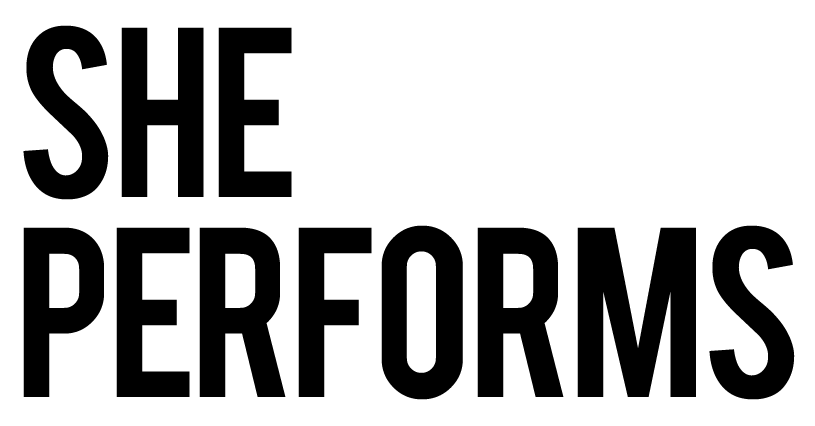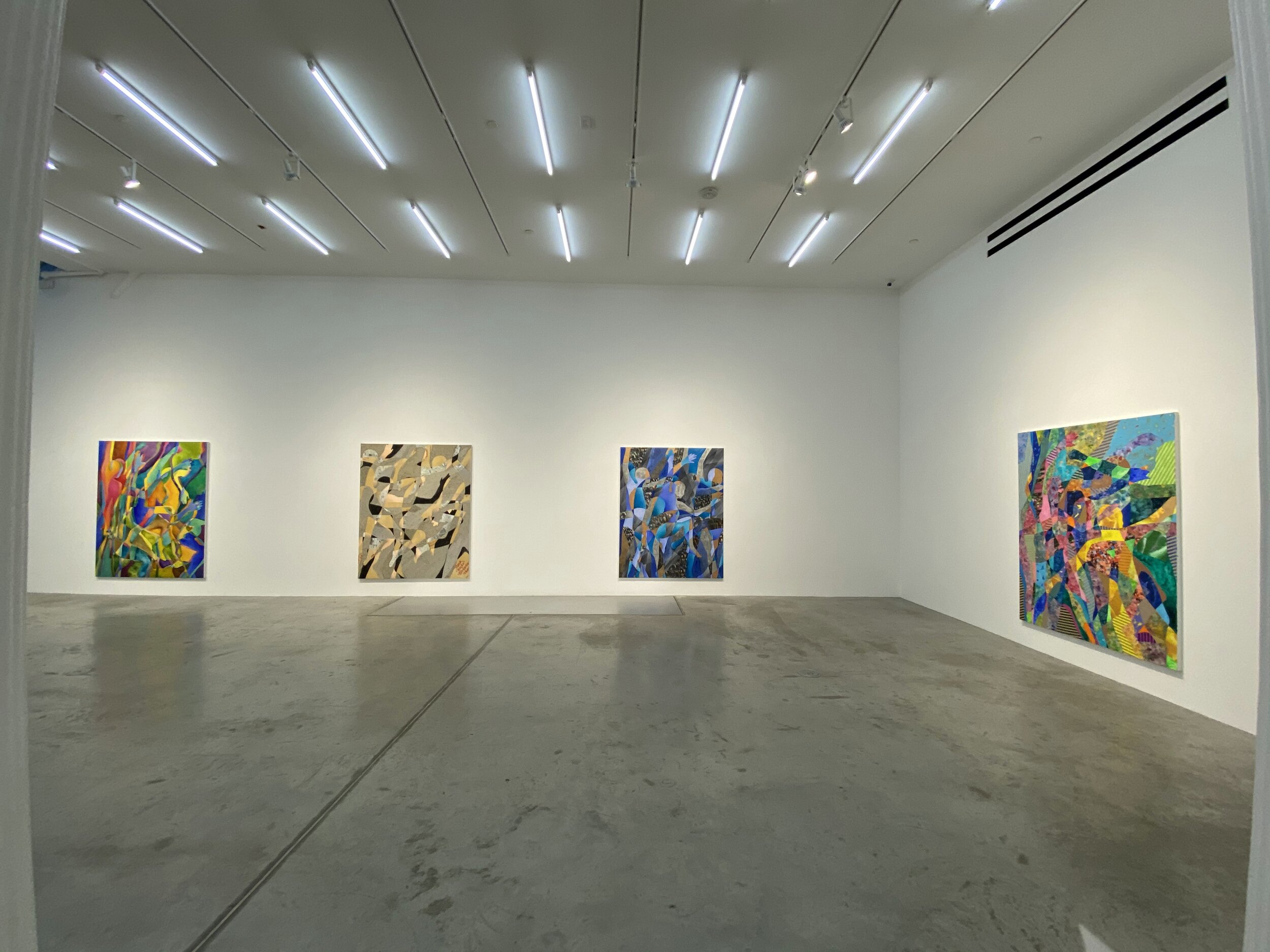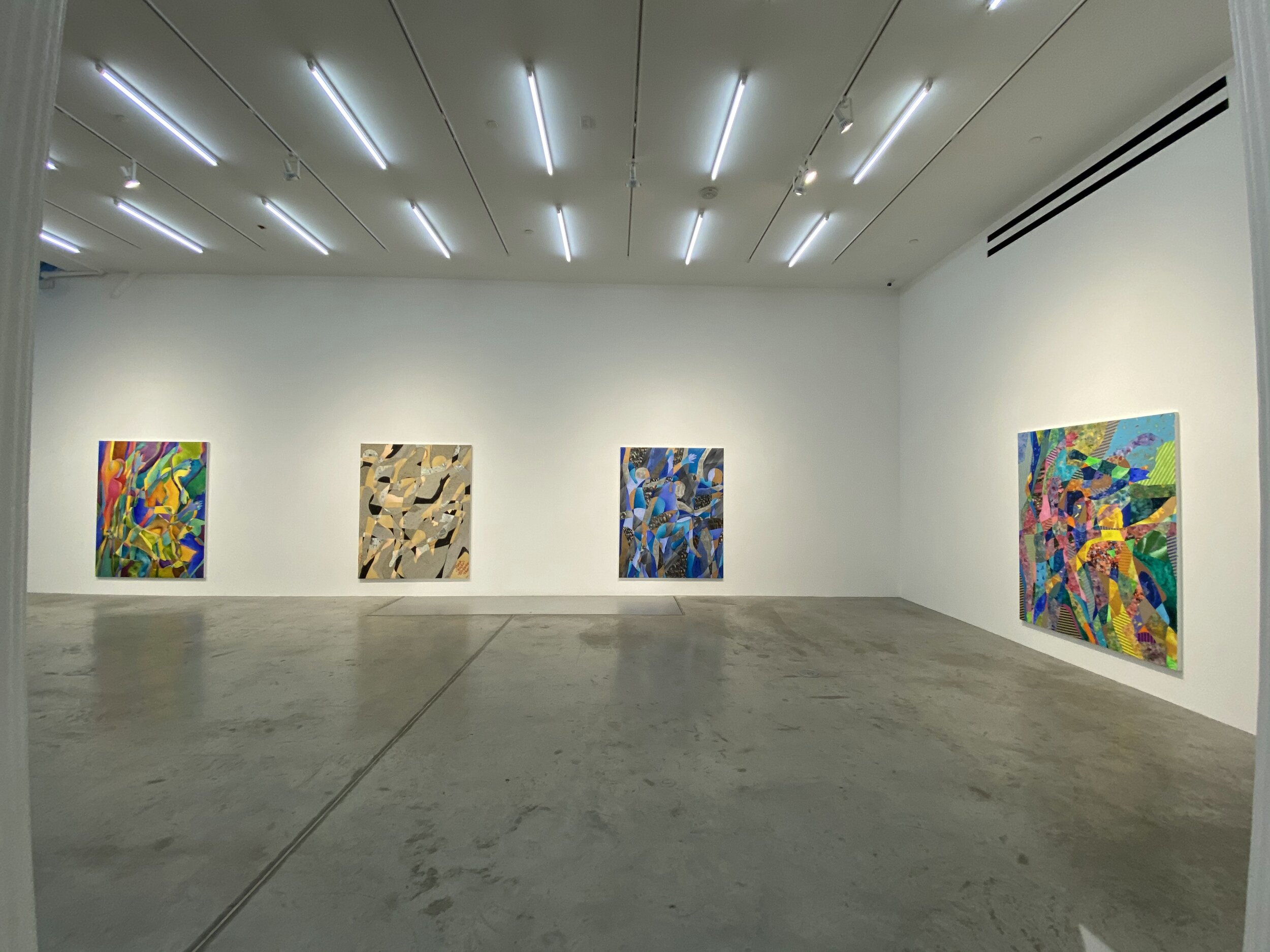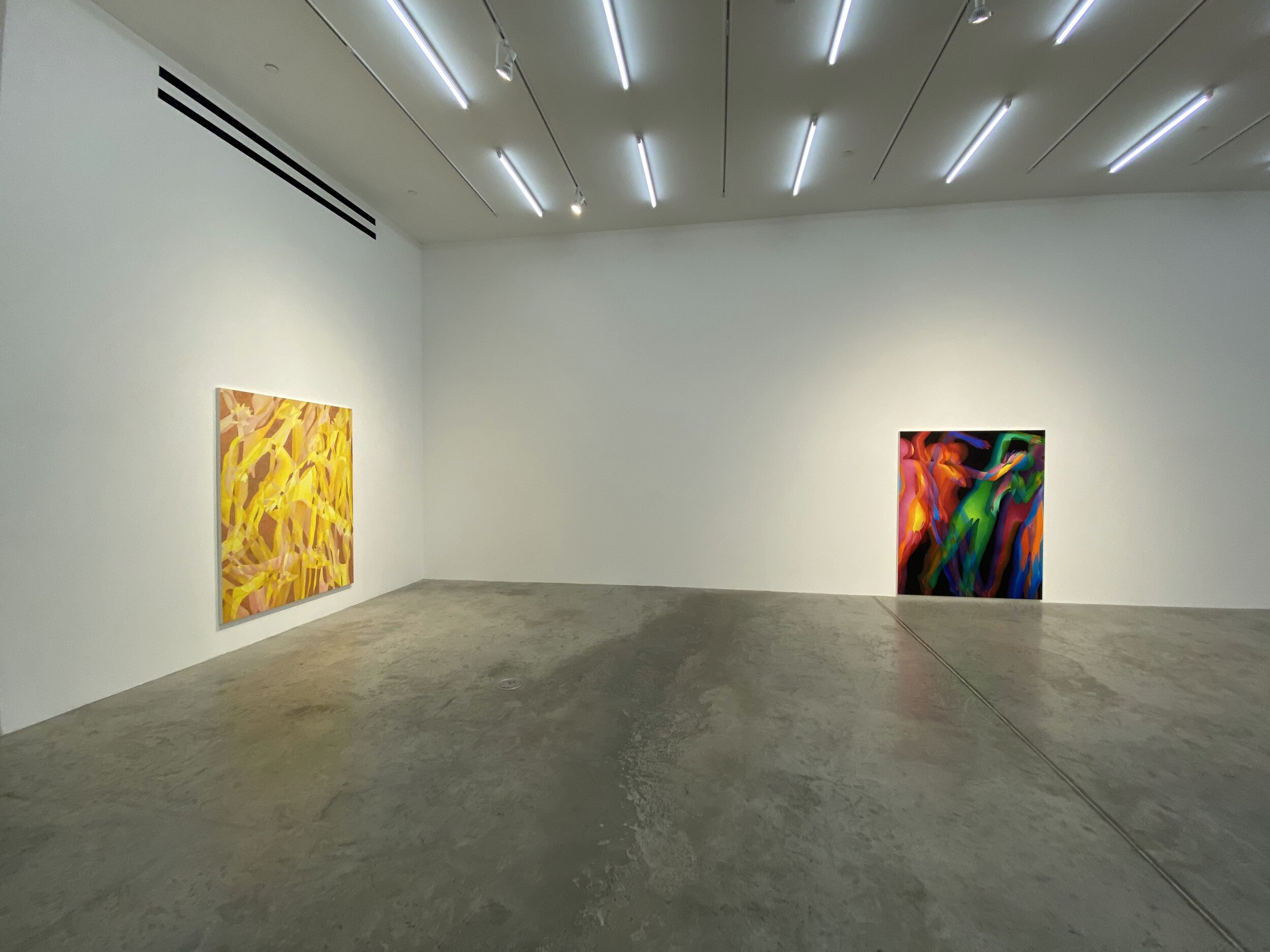NYC: ANNA OSTOYA 'MOTIONS'

She Performs is delighted to introduce our New York correspondent, Caroline Blockus, who sent us this review of Anna Ostoya’s exhibition, Motions at Bortolami Gallery (until 19 December) …
It is a rainy November afternoon when I walk into Bortolami Gallery to view Anna Ostoya’s newest exhibition, filled with works she created during the first COVID-19 lockdown in the spring/summer of 2020. My screen-exhausted eyes feel an immediate sense of revival and excitement as I gaze across the room and catch first impressions: between the symmetry of the eight identical formats and the refreshing burst of colour, I realise how much I missed looking at art in person.
Motions is Ostoya’s fifth exhibition with the gallery. The press release reads how ‘some [works] seem violent, others vulnerable or ecstatic’ and one can feel all of it. Ostoya uses a variety of media, including oil paint, newspapers, printed images (sourced from the internet), metallic leaf, and (the now officially banned in NY) plastic shopping bags.
The subject of motions appears to me almost ironic when for these past months the world seemed to be standing still, waiting for our ‘normal lives’ to restart, especially in New York where at times it seemed that the once so vibrant and pulsing city was stripped of its dynamic and vivid pace.
Simultaneously, by merging the movements and silhouettes, Ostoya has created works that resemble one particular sensation of the first nationwide (or rather, global) lockdown: a routined replication of each day, performed in the same confined space resulting in a nearly indistinguishable mass of motions.
The inspiration for this series came from Ostoya’s previous work (UN)MADE (after Fernhofer) (2017, displayed at Bortolami Gallery in the autumn/winter of 2018). The artist created the piece after repeatedly sketching the outline of her own body directly on the canvas. Just as the works in Motions, (UN)MADE displays ‘the seductive qualities of painting a nude without painting a representation of an idealised body’, to quote the artist herself. This technique further helps to bypass the notorious voyeuristic ‘male gaze’ which too often in the art world results in the objectification of the (female) body.
(UN)MADE (After Frenhofer) (2017) (Photo: Bortolami Gallery)
The first painting of the series is Step. Personally, I find elements of multiple cubist works, but particularly the canonic Nude Descending a Staircase, No. 2 (1912) by Marcel Duchamp in Ostoya’s work. Step - alongside Jump, in that regard - resembles a more vibrant, refreshed, and polished version of that early 20th-Century artwork.
Step (2020), installation view (Photo: Bortolami Gallery)
Slap, on the other hand, sparkes associations with a contemporary, interactive art installation I saw a few years ago: Olafur Eliasson’s Your uncertain shadow (colour) (2010). Unlike Eliasson’s piece, which only comes to life through physical participation, Ostoya freezes the movement. Her colour-filled outlines remind me more of looking through an infrared heat detection lens than of the halo-like colour-silhouettes in Eliasson’s piece.
Quoted in the exhibition’s literature, Ostoya says of the work, ‘I’m trying to get Slap to look violent and fragile […]. The color should be straightforward and simple, to pull once in and to push one out’. And it's true, I am being pulled in by the vibrancy of the colours but also pushed out by the fear of getting trapped inside.
Slap (2020) (Photo: Bortolami Gallery)
Appropriation of known paintings and photographs is a signature technique of Ostoya, although the parallels I am drawing appear to be coincidental rather than intentional.
Ostoya’s style is filled with nods to the past as well as the present. It often consists of a symbiosis between the real and the intensified. As Maria Brewińska put it in the foreword of the Zachęta National Gallery of Art’s Exhibition Catalogue, ‘In her painting, figuration clashes with abstraction through the Cubist method of breaking down realities’.
Forward (2020) (Photo: Bortolami Gallery)
It is very fitting how Forward is composed of old materials, the remnants of a different era, such as the almost iconic plastic shopping bags. Forward reads to me as a memorial and, at the same time, as a manifestation for moving on from those unsustainable daily artefacts included in the piece.
Writing in her ‘Entries’ for the exhibition, Ostoya reminisces, ‘Forward is so 19th c. with its obsolete materials, which makes me think of the masses moving towards grand utopias through grandiose dystopias. That old world that I tasted and I remember.’
Leap (2020), detail
When looking at Leap I can’t help but think of an avant-garde music video, with the dance-like poses and an army of headless suits on their way to (or rather from) execution. There is a darkness to this piece, a violence that is not immediate, but rather something that evolves the longer one looks at it. There is also a level of social criticism that Anna picks up in her comments for Leap and although I do love the aesthetics of a well-fitted suit, I very much enjoy her comparison. One week before the opening she writes, ‘Leap is not yet quite done. At times all these neckties in the collaged images suffocate me. What are ties all about, what do they stand for? Why is it considered elegant to wear a piece of fabric in a shape of a flattened penis under one’s chin? Its mechanism is that of a hanging rope. What is that uniform about? Let’s forget it and come up with new costumes. Let’s introduce nudity as the new formal attire. Anything but no more of these tied-up ties. Leap forward.’
“Why is it considered elegant to wear a piece of fabric in a shape of a flattened penis under one’s chin?”
Action might be the most times-reflective piece; a collage of current events. You see faces, screams, hands, confetti, protest signs, etc. The artist uses some abstraction, similar to Gerhard Richter’s signature technique, to fade out individual faces. The combination of the blurred visuals and the power and emotion behind the chosen images achieve an exciting, almost Francis-Bacon-like tension.
The motions – the chaos – she captures is a representation of the changes that society (and the art industry) are currently going through. Ostoya acknowledges the shift in her commentary. Complaining about her mismanagement of time and thus not being able to focus on a painting she explores, she says, ‘This time calls for mismanagement, for some sort of strike against efficiency’. She continues, ‘The suspension of the pandemic and the urgency of the issues it makes obvious, all that cosmic injustice … that just fucks one’s brain and one’s heart. I mean it fucks me up – I’m on the frontlines of feeling it all and of doing little. And I make these paintings which somehow, maybe, could transcribe, translate, capture something or inspire someone to act. But of course, the possibility for that is so minimal that too often I’m waking up with a feeling of being self-indulgent.’
Anna speaks from a perspective that I am very much resonating with. I find myself in her words. I feel called out just as much as I feel understood, a familiar combination that allows me to overcome the paralysis of my anxiety and heartbreak these past months have caused and work with all the inevitable changes and paradigm shifts to create a better future.
What the gallery has managed particularly well, in my view, is to make the artist’s raw and unfiltered commentary available. Having the artist create the ‘labels’ for the pieces is an extremely valuable practice. It is a wonderful way to convey meaning and establish empathy and an emotional connection between the artist and the audience.
Providing the writing in form of journal entries – as opposed to wall-mounted text next to the respective work – enables a more cohesive and universal exhibition experience. Reading through the booklet the visitor is invited to a playful scavenger hunt to find each work and look for the mentioned details. The chronological order of the entries also allows visitors to come back to certain works, breaking the norm of a linear viewing pattern into a more active exploration. The only thing missing: an opportunity to sit down and indulge in the stories Ostoya shares. But this is rather a problem that has to be accredited to the limitations imposed by COVID-19.
Overall, Motions is a very well executed exhibition that is relevant, accessible, and exciting. Looking at Ostoya’s art feels like looking through an expressionist-cubist kaleidoscope – or as Jeff Dolven put it so cleverly, looking through the ‘Ostoyascope’.
Motions is on display at Bortolami Gallery until 19 December. Opening hours and further information including photos of the works and installation view can be found on the gallery’s website.
Caroline Blockus is an exhibition content curator, interpretive planner and She Performs’ New York correspondent.
Photos courtesy of the author unless otherwise stated.












